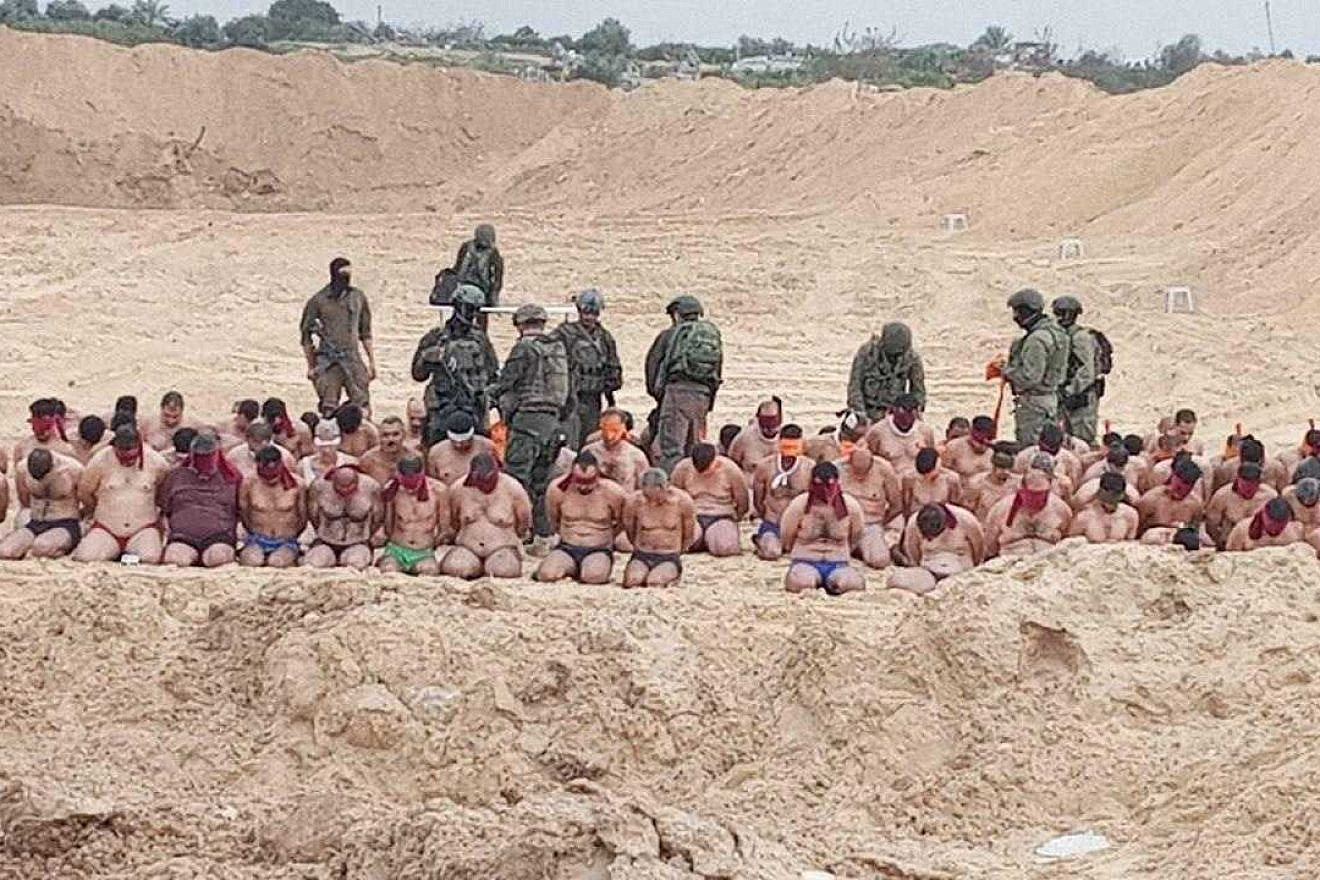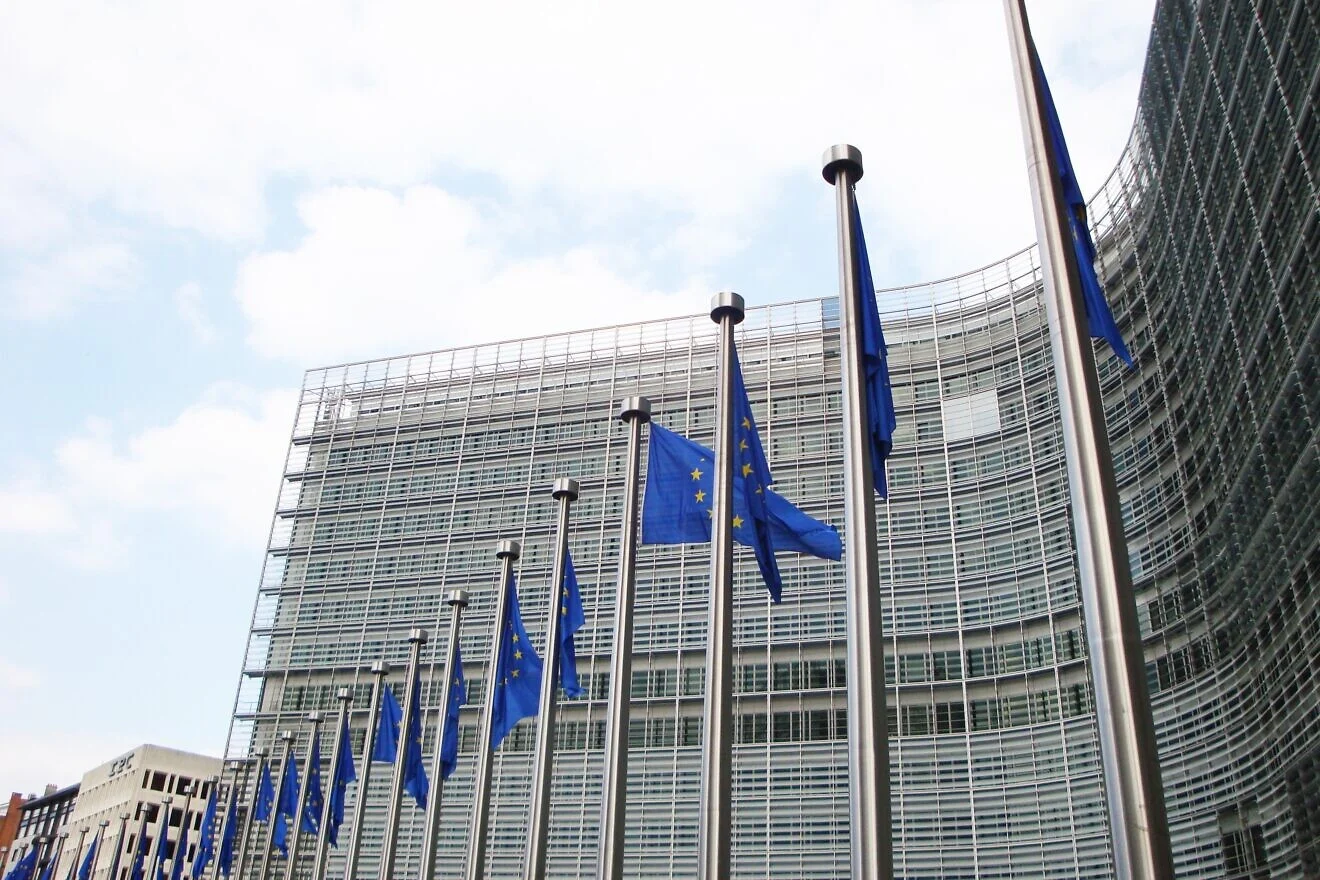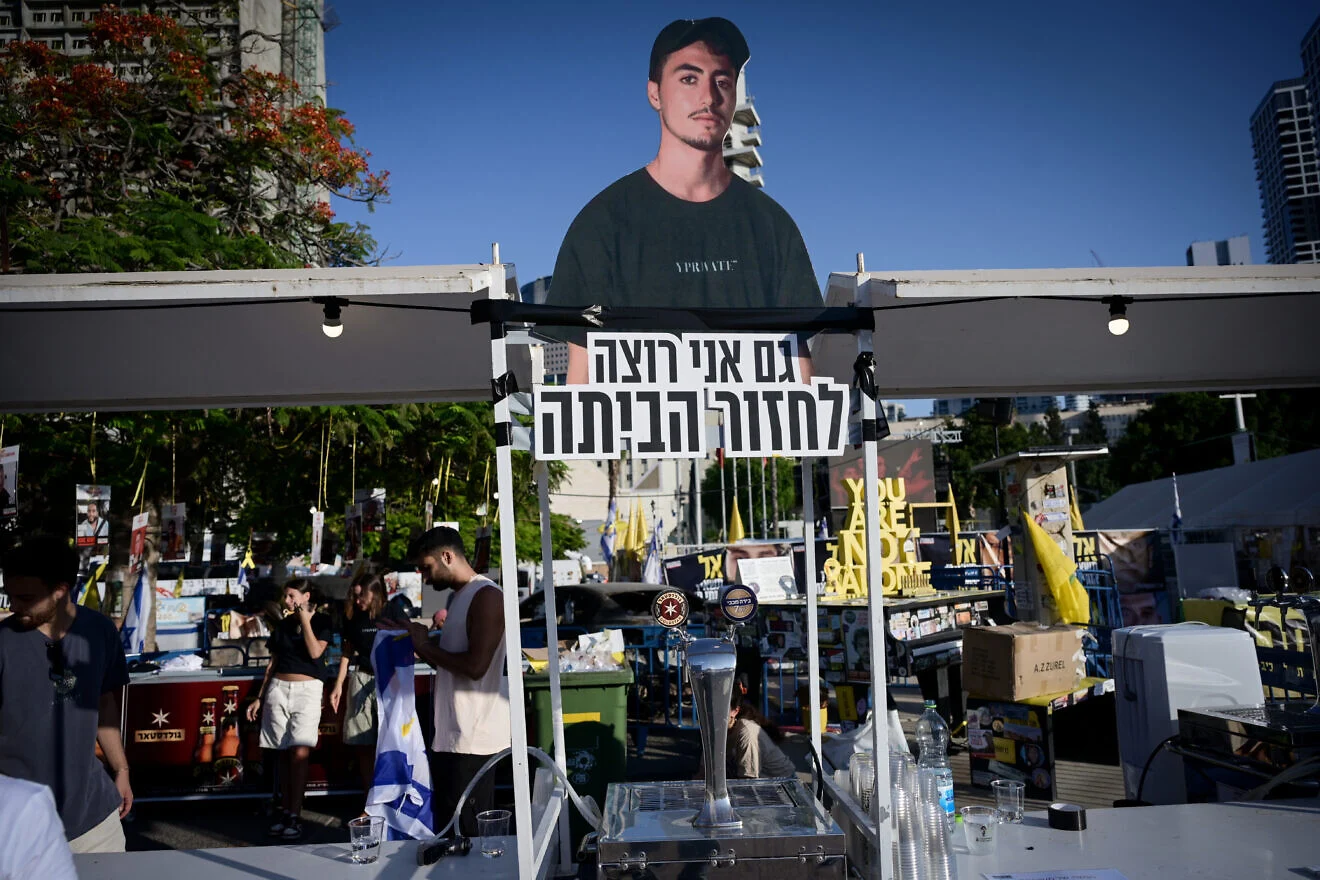Dozens of Palestinian terror suspects were reportedly arrested by the Israel Defense Forces in the northern Gaza Strip on Dec. 7, 2023. Source: Screenshot.
I was poised to go on a live broadcast of WION, an English-language Indian television network, last week to discuss the war against Hamas. But before my turn to speak came, I was startled by the program host’s introduction to the segment. He spoke of images that were shocking the world and the world’s outrage about them, and gave what might be termed a trigger warning for those about to see them for the first time.
As I soon learned, he wasn’t referring to the evidence of the indescribable atrocities committed against Israeli civilians by the Hamas terrorists on Oct. 7. Nor was he even talking about the impact of the war that followed that attack on civilians in the Gaza Strip, who are being used as human shields by those very same terrorists.
Instead, the pictures that really upset him (and, apparently, others throughout the world) were those depicting Palestinians who had surrendered to the Israel Defense Forces. The pictures show the men, all of military age, who had either given themselves up or been captured (most of whom were Hamas operatives), reportedly after having been forced to exit the terrorist organization’s tunnel network.
Images of defeat
The men, heads hung low, are kneeling and stripped down to their underwear with their hands tied. The images are redolent of defeat. Those who not so long ago gloried in the unspeakable suffering inflicted on Oct. 7 as Hamas succeeded in murdering more than 1,200 men, women and children, as well as the rape and torture of the victims and the kidnapping of more than 200 others, were now reduced to the status of helpless captives. The bravado they displayed in the aftermath of the assault on Israel was gone. On their faces could be seen the impact of their defeat, and perhaps, the realization that the calculations of their leadership that those who once ruled Gaza could wage war on Israel with impunity were wrong. While Hamas’s senior leaders live in luxury and safety in Qatar, the terrorist rank-and-file is now paying the price for their folly.
To anyone familiar with the history of warfare in the last century, the sight is hardly unique.
Similar pictures depict those Japanese soldiers who surrendered during World War II as well as other combatants in various wars, especially against terrorist groups. When facing those who are indoctrinated in a cult of fanatical hatred against their enemies and who are likely to attempt to continue to kill even after surrender, stripping prisoners down and ensuring that they are not still armed or wearing booby-trap explosives is simply common sense. The alternative is to risk letting members of a group committed as a matter of faith and political objectives to destroying the State of Israel and slaughtering its population, kill Israelis who believe their opponents have already given up.
Are such images humiliating for those in the pictures? Of course. But if you’re angry about the wounded pride of members of a barbaric terrorist group, then maybe you’re the one who has no moral compass, not the Israelis.
The segment about this issue was not the most elevated discussion in which I’ve participated. I challenged the premise of the host, Mohammed Saleh, about this being an outrage and tried to remind him of the context. He tried to talk over me while the images being shown as we spoke were clearly part of an attempt to depict the Israelis as the villains of the story. Saleh seemed to have trouble grasping the concept that Palestinians could be anything but victims in any interaction with Israel. Nor did he seem to understand that what Palestinians and their sympathizers were protesting was not genocide but the natural consequences of the war they had started.
But he wasn’t alone in his interpretation. Indeed, publications and broadcast networks around the world shared his point of view. Predictably, so did The New York Times, which described the capture of military-age men in areas that most civilians had largely abandoned weeks ago as “mass detention of Gazan men.” The photos were treated as evidence that the IDF was rounding up innocent bystanders as part of a policy of cruelty to poor, oppressed Arabs rather than merely what happens to those who are presumed to be combatants when they are caught by an army conducting a mopping-up operation in areas formerly held by terrorists.
It is true that some of those captured turned out not to be members of Hamas, although most of them were. Any that the IDF determined were not part of the Islamist terror movement were subsequently released. Conspiracy theories floated on social-media sites about those so detained about the prisoners being killed or subjected to torture are easily debunked.
But for all of the ruckus made over the photos—compared to the widespread and utterly false accusations of genocide being hurled at Israel by those who sympathize with Hamas or just hate the Jewish state—the contretemps over these images is small potatoes. After all, taking pictures of captured Palestinians in undershorts is a very small offense compared to the charges based on the unreliable, inflated statistics about casualties supplied by Hamas that assert that all those killed in Gaza are civilians, the majority of them being children.
Those numbers—which, as in past conflicts involving Hamas, likely have little relation to reality—as well as the pictures and video of the devastation inflicted by the war on Gaza are ammunition for those determined to vilify Israel. They also buttress the demands from left-wingers both inside and outside the Biden administration for a permanent ceasefire that would allow Hamas to remain in control of at least parts of Gaza not yet taken by Israel and to essentially let a group bent on the genocide of Jews to get away with mass murder.
But the anger about the photos of the captured Palestinians is still significant.
Hypocritical outrage
The main reaction on the part of much of the international community to the largest mass slaughter of Jews since the Holocaust was not so much indifference as it was outrage that Israel would use military means to ensure that such a horrific crime could not be repeated.
That so many people who cared nothing about the slaughter of Jews by Hamas two months ago, and ignored the widely distributed photo and video evidence (largely compiled by the terrorists themselves on GoPro cameras to publicize the humiliation of their victims) of those crimes, remains deeply shocking to Jews. So, too, is the hypocrisy of feminist leaders and organizations that seemed uninterested in the Palestinians’ deliberate use of rape—against women, children, and, as new reports come out, even men—as a weapon of war.
These crimes against Jews were ignored or quickly forgotten in the rush to deprive Israel of the right to defend itself. It soon became clear even to many Jews who had always been critical of Israeli policies or who sympathized with the suffering of Palestinians that the protests showed that something deeply troubling was behind the outrage about the fighting in Gaza.
Those chanting for a “free Palestine” from “the river to the sea” weren’t advocating for peace or a two-state solution. Their position was that Israeli suffering was unimportant because the Jewish state had no right to exist and should be “decolonized.” If that meant more Oct. 7-style atrocities, then so much the worse for the Jews, who were supposedly guilty of possessing “white privilege” and oppressing “people of color.” The fact that this conflict has nothing to do with race—and that the Jews are the indigenous people of Israel and that the majority are “people of color” who immigrated from other parts of the Middle East and North Africa—counts for little among those who buy into intersectional myths and think the Jewish state should be erased and its people subjected to genocide.
Jews are no longer ‘dhimmi’
But the pictures of Palestinian prisoners do touch a nerve throughout the world, and the reason for that goes far to explain why Palestinian Arabs—with the support of much of the Islamic world—persist in their century-old war against Zionism.
It is hardly surprising that images of Jewish suffering do not move the not-insubstantial percentage of the world’s population that thinks the Jews are not entitled to sovereignty or the right of self-defense in their ancient homeland. But what they really can’t stand is the idea that Jews are no longer homeless or at the mercy of a hostile world, as they were before the establishment of modern-day Israel in 1948. The notion that a despised minority, against whom the virus of antisemitism continues to incite unthinking hatred and demonization, are now powerful enough to defeat their foes is difficult for them to swallow.
This goes beyond sympathy for the Palestinians. They are trapped in an irredentist mindset that not only prevents them from accepting the multiple offers of statehood and peace Israel has made over the years but causes them to see a refusal to accept the Jewish state’s legitimacy and permanence as inextricably linked with their national identity.
The photos of Hamas prisoners are, by the standards of war photography, nothing particularly unusual or outrageous, and certainly not evidence of abuse. The documentation of their detention is certainly preferable to the silence that Hamas continues to adhere to about the fate of the hostages they have not yet released of whom no proof of life in any form has been forthcoming.
Yet the photos do seem outrageous to those who, whether Muslims or not, see Jews as what the Islamic world traditionally referred to as dhimmi. In Islamic societies, the dhimmi were “protected” residents of a country but treated as inferior to Muslims. Indeed, the photos provoke anger because they show that Hamas, which rightly anticipated that their atrocities would spark a surge in antisemitism rather than a backlash against them, is losing the war they started against the Jews. Their humiliation is evidence that their understanding of the world has been turned upside-down with the Jews no longer relegated to the status of a despised and powerless minority.
The anger about the images of Palestinian prisoners is not a reaction to evidence of Israeli crimes. Instead, it is more proof that the anti-Israel protests that have proliferated in the United States and elsewhere are motivated largely by antisemitic motives, whether rooted in modern leftist theories or historic religious hatred. Rather than a sidebar to the debate about the war, the anger about the photos shows us just how deep intolerance for Israel and the Jews runs.
Source: JNS



































